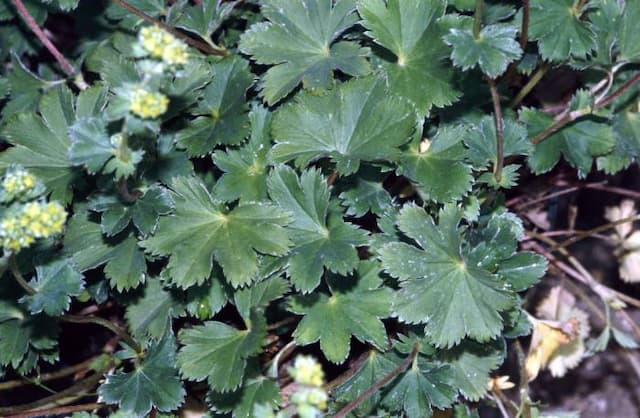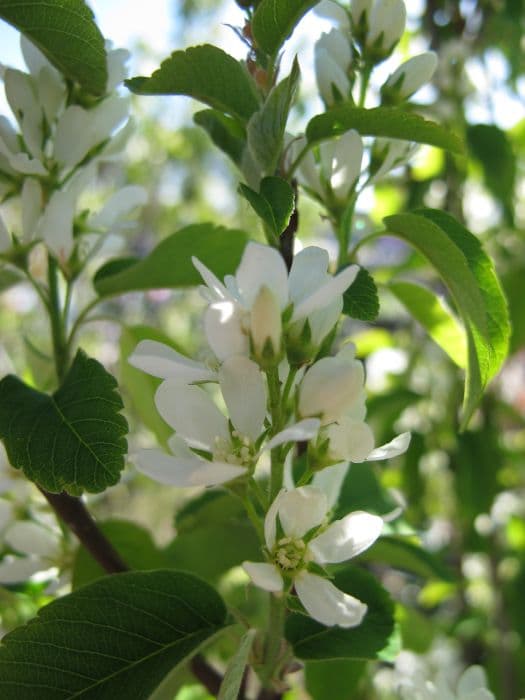Raspberry Rubus idaeus 'Malling Minerva' (F)

ABOUT
The Rubus idaeus 'Malling Minerva' (F), commonly known as the raspberry plant, is characterized by its lush, green foliage, with each leaf composed of multiple leaflets that display a jagged edge. The leaves are arranged on canes that grow from the plant's base, which can be either sturdy or slightly arching due to the weight of the foliage and fruit. The plant's standout features are its fruit: clusters of berries that start as small green nodules and develop into plump, red raspberries with a juicy texture and a sweet flavor. These berries have a fuzzy surface and are made up of many individual drupelets that surround a central core. As the fruit matures, the red deepens to a rich, ruby color. Raspberry plants typically have a multi-year life cycle, where the first year's growth, known as primocanes, produces only leaves, and the following year's growth, or floricanes, produces both leaves and the coveted fruit. Additionally, the raspberry has white blossoms with multiple petals and a light, sweet aroma that attract pollinators before the fruit sets in. Overall, the plant has a bushy appearance and provides a bountiful harvest when properly taken care of.
About this plant
 Names
NamesFamily
Rosaceae
Synonyms
Red Raspberry, European Raspberry, Malling Minerva Raspberry
Common names
Rubus idaeus 'Malling Minerva' (F).
 Toxicity
ToxicityTo humans
The Rubus idaeus 'Malling Minerva' is a cultivar of the raspberry plant. Raspberries are not toxic to humans and are in fact widely consumed around the world for their flavor and nutritional benefits. The fruit is commonly eaten raw, in desserts, and in a variety of other culinary applications. There are no common symptoms of poisoning from raspberries because they are safe for human consumption. However, as with any food, overconsumption can lead to gastrointestinal discomfort or other issues related to diet.
To pets
The raspberry plant, Rubus idaeus 'Malling Minerva', is generally considered non-toxic to pets such as dogs and cats. Pets can sometimes eat raspberries in small quantities without adverse effects. However, it is important to note that the ASPCA lists the raspberry plant as potentially harmful to pets if consumed in large quantities due to the possibility of gastroenteritis or diarrhea. Always moderate the amount of raspberries given to pets and consult with a veterinarian if there are any concerns regarding your pet’s health after consuming this or any other plant.
 Characteristics
CharacteristicsLife cycle
Perennials
Foliage type
Deciduous
Color of leaves
Green
Flower color
White
Height
5 feet (1.52 meters)
Spread
4 feet (1.22 meters)
Plant type
Shrub
Hardiness zones
4
Native area
Europe
Benefits
 General Benefits
General Benefits- Edible Fruits - The plant produces raspberries which are enjoyed fresh, in culinary recipes, or preserved as jams and jellies.
- Attractive to Wildlife - Bees, butterflies, and other pollinators are drawn to the plant's flowers, providing essential support for biodiversity.
- Easy to Grow - Adaptable to a variety of soils, it's a hardy plant that's easier for gardeners to grow compared to some other fruit plants.
- Extended Harvest Season - Offers a longer harvesting period as it can produce fruit throughout the summer and often until the first frost.
- Home Garden Aesthetic - The plant adds aesthetic value to gardens with its attractive foliage and fruit.
- Low Maintenance - Requires minimal care once established, with a basic need for pruning and occasional feeding.
- Space Efficiency - Suitable for small gardens or even container gardening, doesn't require a large space to yield fruit.
- Soil Enrichment - Can improve soil quality through leaf litter and root structure, beneficial for garden soil health.
- Erosion Control - The dense growth habit of the plant can help prevent soil erosion in certain garden settings.
- Sustained Yield - Plant can produce fruit for many years, providing a long-term return on investment for the garden.
 Medical Properties
Medical Properties- Anti-inflammatory Effects: The leaves and fruit of raspberry (Rubus idaeus) contain bioactive compounds that may have anti-inflammatory properties.
- Antioxidant Properties: Raspberry fruit is rich in antioxidants, which can help protect the body from oxidative stress and may have various health benefits.
- Gastrointestinal Aid: Raspberry leaf tea has been traditionally used to aid digestion and treat gastrointestinal discomfort.
- Mensuration and Labor Aid: Raspberry leaf is commonly used in herbal medicine to support menstrual health and may be used to assist with labor in pregnant women.
- Antimicrobial Activity: Some studies suggest that raspberry extracts may possess antimicrobial properties against certain pathogens.
 Air-purifying Qualities
Air-purifying QualitiesThis plant is not specifically known for air purifying qualities.
 Other Uses
Other Uses- Dye Production: Red raspberry leaves can be used to make a natural green dye for fabrics and textiles.
- Photography: The tannin-rich leaves can be used in alternative photography printing processes like anthotypes, producing images on paper.
- Companion Planting: Red raspberries can be planted near other crops to deter certain pests, taking advantage of the plant's natural repellent properties.
- Educational Tool: The plant can serve as an example in educational settings to explain pollination, fruit development, and plant propagation techniques.
- Flavoring for Beverages: Leaves and berries can be used to flavor fermented beverages like beers and ciders to give them a unique taste.
- Culinary Garnish: The aesthetically pleasing leaves and berries can be used as garnishes to enhance the presentation of gourmet dishes.
- Erosion Control: The root system of red raspberry plants can help stabilize soil in areas prone to erosion.
- Habitat Creation: By planting red raspberries, gardeners can provide food and shelter for wildlife, including birds and beneficial insects.
- Craft Material: The canes of the raspberry plant, once dried, can be used to create woven items such as baskets and mats.
- Natural Fertilizer: After pruning, raspberry canes and leaves can be composted and used to add nutrients back into the garden soil.
Interesting Facts
 Feng Shui
Feng ShuiRaspberry is not used in Feng Shui practice.
 Zodiac Sign Compitability
Zodiac Sign CompitabilityRaspberry is not used in astrology practice.
 Plant Symbolism
Plant Symbolism- Protection: The thorny canes of the raspberry bush are often seen as a symbol of protection, guarding whatever is within its reach.
- Innocence: The pure, sweet fruit of the raspberry can represent innocence and purity.
- Feminine Qualities: With its delicate fruit and thorny branches, the raspberry plant is sometimes associated with femininity and motherhood.
- Kindness: Sharing a raspberry is seen as an act of kindness, indicating the sweet joy one person can give to another.
- Fertility: The raspberry's robust growth and abundance of fruit can symbolize fertility and abundance.
- Youth and Vitality: As raspberries are full of nutrients and life-sustaining qualities, they can signify youth and vitality.
 Water
WaterRaspberry plants, such as the 'Malling Minerva', should be watered regularly to keep the soil consistently moist but not waterlogged. Generally, watering once a week with about 1 to 2 gallons of water per plant is sufficient, but this can vary depending on climate and soil conditions. During the hotter seasons or drought conditions, the frequency may need to be increased to maintain proper soil moisture. It's best to water the base of the plant without wetting the foliage to prevent fungal diseases. During the winter months, reduce the amount of water as the plant requires less moisture when dormant.
 Light
LightRaspberries, including the 'Malling Minerva' variety, thrive in full sunlight, receiving at least 6 to 8 hours of direct sunlight daily. An ideal spot for these plants would be an area with clear exposure to the sun throughout the day with little to no shade. Avoid planting them where buildings, trees, or other structures will cast shadows and limit their sun exposure.
 Temperature
TemperatureThe 'Malling Minerva' raspberry thrives in a temperature range between 55°F and 75°F, which provides the ideal conditions for growth and fruit development. While these plants can tolerate temperatures as low as 20°F and as high as 85°F, temperatures outside this range for extended periods can be detrimental. They are cold-hardy perennials and can survive winter temperatures down to 20°F, however, providing winter protection can help ensure the best yield in the following season.
 Pruning
PruningPruning is vital for 'Malling Minerva' raspberries to promote healthy growth and maximize fruit production. Prune in the late winter or early spring before new growth begins, removing all dead, damaged, or weak canes to allow room for new canes to grow. Prune canes that have fruited right after harvesting, as raspberries fruit on biennial canes. Pruning annually will also improve air circulation and reduce the risk of disease.
 Cleaning
CleaningAs needed
 Soil
SoilRaspberry 'Malling Minerva' prefers a well-drained, fertile soil with a pH of 5.5 to 6.5. A mix of loam, peat, and aged compost, with a layer of mulch to retain moisture and suppress weeds, is ideal for optimal growth and fruit production.
 Repotting
RepottingRaspberry 'Malling Minerva' typically does not need repotting as it is most often grown outdoors. In a container, repot every 2-3 years or when the plant outgrows its current pot.
 Humidity & Misting
Humidity & MistingRaspberry 'Malling Minerva' tolerates a wide range of humidity levels but it thrives with average to high humidity; avoid extremely dry conditions.
 Suitable locations
Suitable locationsIndoor
Provide bright light, cool temps, and ample air movement.
Outdoor
Full sun, well-drained soil, and regular pruning for best health.
Hardiness zone
4-8 USDA
 Life cycle
Life cycleThe life of the raspberry 'Malling Minerva' begins with seed germination, where the seeds sprout in moist soil conditions during spring. Once the seedlings emerge, they develop into young plants with leaves and a root system, entering the vegetative stage where they primarily focus on growth. As the plants mature, they transition to the reproductive stage, producing flowers which, upon pollination, develop into the characteristic raspberries during late spring to early summer. The fruiting stage follows, with ripe raspberries typically ready for harvest in midsummer. After fruiting, the plant enters a period of dormancy in the fall and winter where growth slows down significantly. In the subsequent year, the perennial canes (stems) of the 'Malling Minerva' raspberry will regenerate, and the cycle repeats, with new canes emerging to replace the ones that fruited the previous year.
 Propogation
PropogationPropogation time
Spring-Early Summer
The most popular method of propagation for the raspberry variety Rubus idaeus 'Malling Minerva' (F) is by taking tip or root cuttings. For tip cuttings, in the late summer, dig up a cane tip that has rooted into the soil, sever it from the main plant, and replant it in well-draining soil. Ensure the new planting site is prepared with ample organic matter to encourage growth. For root cuttings, in the early spring or late fall when the plant is dormant, take a cutting of the root, about 4 to 6 inches (10 to 15 centimeters) long. Plant the cuttings horizontally, about 2 inches (5 centimeters) deep in a potting mix or directly in the soil at the growing site. Keep the soil consistently moist, but not waterlogged, to promote root development and establish new plants.









